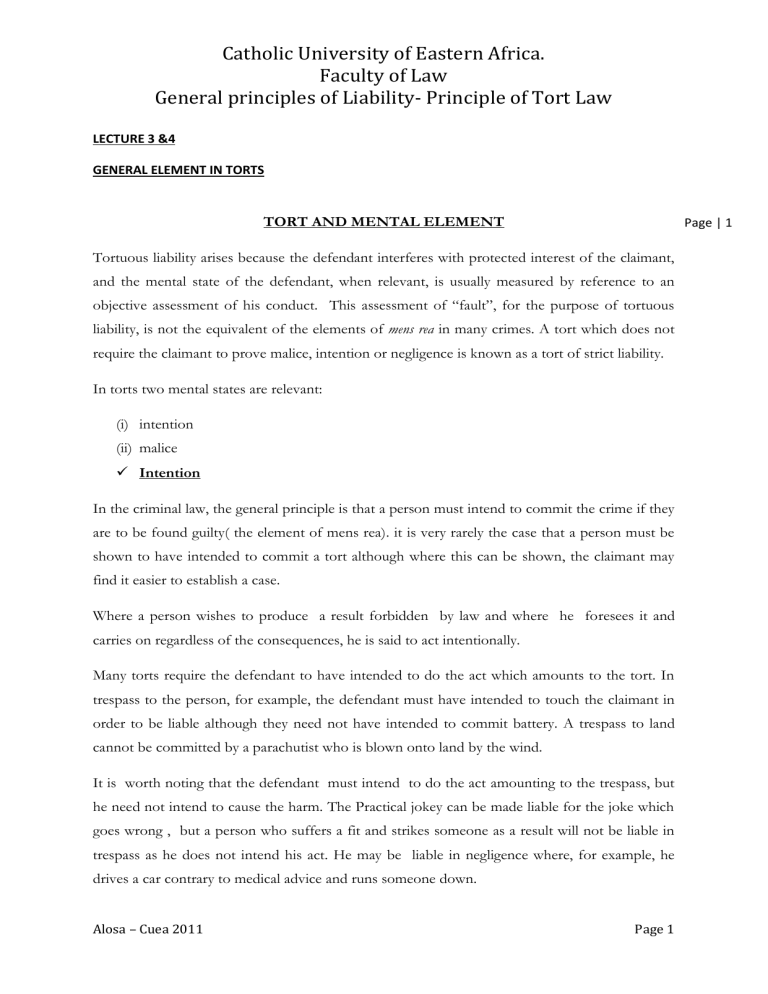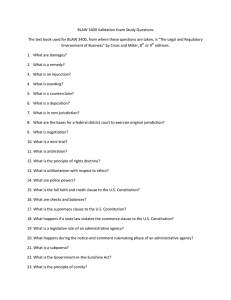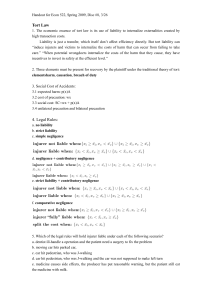
Catholic University of Eastern Africa. Faculty of Law General principles of Liability- Principle of Tort Law LECTURE 3 &4 GENERAL ELEMENT IN TORTS TORT AND MENTAL ELEMENT Page | 1 Tortuous liability arises because the defendant interferes with protected interest of the claimant, and the mental state of the defendant, when relevant, is usually measured by reference to an objective assessment of his conduct. This assessment of “fault”, for the purpose of tortuous liability, is not the equivalent of the elements of mens rea in many crimes. A tort which does not require the claimant to prove malice, intention or negligence is known as a tort of strict liability. In torts two mental states are relevant: (i) intention (ii) malice Intention In the criminal law, the general principle is that a person must intend to commit the crime if they are to be found guilty( the element of mens rea). it is very rarely the case that a person must be shown to have intended to commit a tort although where this can be shown, the claimant may find it easier to establish a case. Where a person wishes to produce a result forbidden by law and where he foresees it and carries on regardless of the consequences, he is said to act intentionally. Many torts require the defendant to have intended to do the act which amounts to the tort. In trespass to the person, for example, the defendant must have intended to touch the claimant in order to be liable although they need not have intended to commit battery. A trespass to land cannot be committed by a parachutist who is blown onto land by the wind. It is worth noting that the defendant must intend to do the act amounting to the trespass, but he need not intend to cause the harm. The Practical jokey can be made liable for the joke which goes wrong , but a person who suffers a fit and strikes someone as a result will not be liable in trespass as he does not intend his act. He may be liable in negligence where, for example, he drives a car contrary to medical advice and runs someone down. Alosa – Cuea 2011 Page 1 Catholic University of Eastern Africa. Faculty of Law General principles of Liability- Principle of Tort Law In the tort of negligence, the defendant is liable for unintended consequences of an act. Liability rests on the fact that the defendant failed to foresee the potential consequences and thus failed to guard against them. if the consequences are intended, then some other torts may have been committed. By way of example, if a motorist deliberately rams another vehicle, there may be liability for trespass to the person or to goods, but there will be no liability for negligence. Malice In some rare circumstances, the defendant’s motive may be relevant. An improper motive usually referred to as malice and its presence can have the effect or rendering what might otherwise be a reasonable action unreasonable and therefore unlawful. Malice in tort posses’ two distinct meanings. It may be: - The intentional doing of some wrongful act without proper excuse; or - Acting with some collateral or improper motive There is a general principle that malice is irrelevant in tort law. If a person’s has a right to do something then his motive in doing it is irrelevant. Equally , the fact that a person violates another’s right intentionally rather than carelessly does not aggravate that person’s responsibility in tort. Examples of this are found in the tort of malicious falsehood and in nuisance. Malice may also defeat the defense of qualified privilege available in defamation. In Bradford Corporation v Pickles (1895) The defendants had extracted percolating water which flowed under his land in undefined channels, with the result that the water supply to the claimant’s reservoir was reduced. The defendant’s motive was to compel the claimant to buy his land at his price. The claimant’s action failed as the defendant had a right to extract the water and his motive was irrelevant. There are exception to this principle. For example , mlice may be relevant to liability without being part of the definition of the tort. In private nuisance the question is whether the defendant’s behavior is reasonable and a bad motive(malice) may be a factor in deciding that an act in a nuisance. Alosa – Cuea 2011 Page 2 Page | 2 Catholic University of Eastern Africa. Faculty of Law General principles of Liability- Principle of Tort Law In Christie v Davey. The plaintiff had been giving music lessons in his semi-detached house for several years. The Defendant irritated by the noise banged on the walls , shouted , blew whistles and beat tin tray’s with malicious intention of annoying his neighbour and spoiling the music lesson . An injustion was granted to restrain the defendants behavior. Page | 3 In Hollywood Silver Fox Farm v Emmett[1936] the defendant, after a quarrel with the claimant , made arrangements for guns to be fired close to the border of his own land and that of the claimant during the breeding season of the claimant’s silver foxes. He was aware that the foxes were sensitive to noise at this time. An injunction was granted to restrain him. This case must be distinguished from Bradford Corporation v Pickles as in Christie and Emmett, the actions of the respective defendants in making a noise on their own land must be judges against the interest of neighbouring occupiers. There is no absolute right to make noise, nor absolute protection from noise. Once again, the essential task of the tort of private nuisance, attempting to balance conflicting interests, is apparent. The reason for making the noise may become relevant factor in determining whether the amount of noise is an unreasonable interference. Negligence Negligence is a tort in its own right but the word is used here in the sense of careless conduct. In practice, most decided torts cases turn on negligence. It is important to note that it does not truly describe a state of mind; when a court finds a defendant not to be negligent, it is making an assessment of his conduct by looking back to the time when that conduct cased harm to the claimant. The person who totally disregards the safety of other but does not injure them mau be morally reprehensible but is not guilty of negligence; the person who tries his best and still falls below the relevant legal standards of behavior is liable in tort for damages he causes. Strict Liability It is not always necessary to prove fault and carelessness in order to establish liability in tort. Sometimes tort la holds a defendant liable even when that defendant has taken every reasonable care to avoid an accident- that is , the law imposes strict liability on the defendant. An example of strict liability (typically called vicarious liability) is the liability of an employer for the torts that an employee commits in the course of the employer’s business. Alosa – Cuea 2011 Page 3 Catholic University of Eastern Africa. Faculty of Law General principles of Liability- Principle of Tort Law Another example of strict liability is liability for dangerous substances that escapes and cause damage to another persons’s use and enjoyment of land( See Rylands v Fletcher [1868]; there too it is not necessary to prove that such damage was the result of carelessness and fault. Intention, Motive, Negligence and Recklessness Page | 4 An obligation to make reparation for damage caused by a wrongful act arises from the fault, and not from the intention. An invasion of the civil right of another is in itself a legal wrong, carrying with it liability to repair its necessary or natural consequences, in so far as these are injurious to the person whose right is infringed, whether the motive which prompted it be good , bad or indifferent. A thing which is not a legal injury or wrong is not made actionable by being done with a bad intent. It is no defense to an action in tort for the wrong –doer to plead that he did not intend to cause the damage, if damage has resulted owing to an act or omission on his part which is actively or passively the effect of his volition. A want of knowledge of the illegality of his act or omission afford no excuse, except where fraud or malice is the essence of that act or omission. For every man is presumed to intend and to know the natural and ordinary consequences of his acts. The defendant will be held liable for the natural and necessary consequence of his act, whether he in fact contemplated them or not. See Scott v Shepherd- the lighted squib case. The lesser state of mind may be regarded as negligence or recklessness. These distinction have been illustrated by admirable illustration by Professor Street. “if a man throws a stone at a woman, his trespass to her person is intentional, that he threw it because she had jilted him would be immaterial in determining his liability in trespass- that would be his motive. If he did not throw the stone for the purpose of hitting her but ought to have foreseen that it was likely that the stone would hit her, his act would be unintentional but nevertheless negligent. If the stone hit her solely because it rebounded off a tree at which he had thrown it his conduct would be voluntary; and the hit would be accidental. But, if while he was holding the stone in his hands, a third party seized his arm and by twisting it compelled him to release his hold on it, whereupon it fell on the woman, his conduct would be involuntary and could never give rise to a liability on his part..” Alosa – Cuea 2011 Page 4 Catholic University of Eastern Africa. Faculty of Law General principles of Liability- Principle of Tort Law NB: in the case where the stone thrown at a tree rebounds and hits the woman it is assumed that the risk that the stone on rebound may hit the woman could not be reasonably foreseen which negatives negligence, and therefore, it is an accident though the act of throwing the stone is voluntary. In this case also there will be no liability Page | 5 Where the third person twists the arm of the person holding the stone and the stone gets released, the act of the person holding the stone is involuntary and so he would not be liable for trespass; but, the person twisting the arm and compelling the release of the stone so that it may hit the woman will be guilty of trespass. Malfeasance: Misfeasance: and Non-feasance Malfeasance- refers or applies to the commission of an unlawful act. It is generally applicable to those unlawful; acts, such as trespass, which is actionable per se and do not require proof of negligence or malice. Misfeasance- this term refers or is applicable to improper performance of some lawful act. Non-feasance- applies to the failure or omission to perform some act which there is an obligation to perform. Fault Liability for tort generally depends upon something being done by a man which can be regarded as a fault for the reason that it violates another man’s right. But liability may also arise without fault. Such liability is known as absolute or strict liability. Consequently the law of tort presupposes two extreme i.e. non-liability even where there is a fault and of liability without a fault. As between these two extreme are the variety of intentional and negligent wrongs begging the question whether there is any consistent theory of liability, all that can be said is that it wholly depends upon flexible public policy, which in turn is a reflection of the compelling social need of the time. Alosa – Cuea 2011 Page 5 Catholic University of Eastern Africa. Faculty of Law General principles of Liability- Principle of Tort Law Most torts are based on the fault principle. Under this principle , it is necessary to establish some fault on the part of the wrong does because he can be made liable in tort. A person is said to be at fault where he fails to live up to some ideal standard of conduct set by law. Three elements are relevant in the determination of fault, and any one of them may be relied upon:- Page | 6 (i) Intention: Where a person does a wrongful act desiring that its consequences should follow, he is said to have intended it; and to that extent there is some amount of fault on his part. (ii) Recklessness: An act is said to be done recklessly where it is done without caring whatever its consequences might be. Recklessness, as such constitutes fault on the part of the wrongdoer. (iii) Negligence a person is also at fault where he does a wrongful act negligently i.e where the circumstances are such that he ought to have foreseen the consequences of his act and avoided it altogether. (Here, we are concerned with negligence as an element of fault). The deficiencies of a fault –based system in providing speedy compensation for accident victims who suffer personal injuries are now frequently debated. Schemes to provide compensation without proof of fault are proposed in certain fields of activity, for example in medical negligence cases. END. Alosa – Cuea 2011 Page 6








